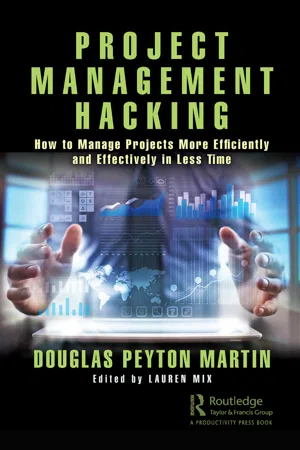
Project Management Hacking
How to Manage Projects More Efficiently and Effectively in Less Time
- 74 pages
- English
- ePUB (mobile friendly)
- Available on iOS & Android
Project Management Hacking
How to Manage Projects More Efficiently and Effectively in Less Time
About This Book
This book provides the much-needed, no-nonsense guidance crucial for project managers – that is, the type of guidance that is missing from every major body of knowledge and educational offering for working project managers. This very practical book identifies the activities that influence project success and focuses the limited time and energy available towards just those activities.
The Project Management Institute (PMI) and most literature on project management discusses all aspects of project management under the assumption that project managers will narrow down focus because they cannot be expected to use every process outlined by PMI to manage every project. This book uses the concept of "hacking" our standard conventions of project management and outlines a standard path identified by conventional wisdom, an evil path that project managers frequently resort to under time/quality pressures, and a hacker path that provides a better way to look at the challenge.
This book equips project managers with streamlined approaches to refocus their efforts on factors that matter while spending less time doing it. Project management is a demanding discipline with a growing body of knowledge with few instructions on how to do it all.
The author provides humorous anecdotes and examples while teaching readers how to save time, improve quality, and advance their career. The primary sections of the book cover how to approach the most common certifications in project management; continuing education; leading project teams; initiating, planning, executing, monitoring, and controlling projects; general life skills; and taking on additional responsibilities. Hacking project management is about focusing the limited bandwidth a project manager can give a project towards the activities that drive success.
Frequently asked questions
Information
1
Getting Certified
PMP®
The Standard Path
- 1. Go to the PMI website and read the current credential guide. Satisfy the experience and education requirements with a reputable education provider.
- 2. Study like a neurotic maniac for months.
- 3. Sit the exam.
The Evil Path
The Hacker Path
- 1. Regardless of how trivial or silly the issue sounds in the scenario given in the exam question, the project manager is always proactive and will act sooner rather than later.
- 2. The project manager will never break the law or act in an unethical manner. The project manager will honor and respect local customs.
- 3. If an available answer is “call a meeting to discuss the issue,” odds are it is the right answer.
- 4. Some questions provide the answer to others in the exam. This frequently comes up in the inputs/outputs/tools/techniques questions.
- Initiating and Planning Activities will almost always include Organizational Process Assets and Enterprise Environmental Factors as Inputs.
- Monitoring and Controlling – Work performance data is almost always an input. Change requests are almost always an output (with the exception of “Perform Integrated Change Control”).
- The output for the planning activity is the plan for that process. For example, the “Plan Schedule Management” activity will have an output of a schedule management plan.
- The input for the monitoring and controlling activity is the activity’s plan. Outputs will be updates to the plan, forecasts, and logs of the same activity type.
PMI-ACP®
The Standard Path
- 1. Read the 12 sourcebooks.
- 2. Begin using Agile principles in project work to gain experience hours.
- 3. Take a prep course.
- 4. St...
Table of contents
- Cover
- Half-Title
- Title
- Copyright
- Dedication
- Contents
- Foreword
- Preface: Why Buy This Book
- Author
- Introduction
- 1 Getting Certified
- 2 Professional Development and Continuing Education
- 3 Leading the Project Team
- 4 Initiating and Planning Projects
- 5 Executing, Monitoring, and Controlling Projects
- 6 Closing Projects
- 7 General Life Skills
- 8 Performs Other Duties as Assigned
- 9 Summary
- Index